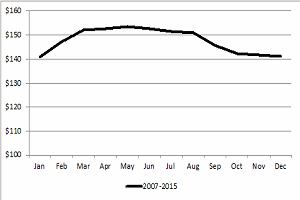By Dr.Kenny Burdine,
The feeder cattle market took yet another hit over the last month. The April 2017 CME© Live cattle futures contract lost around $10 per cwt from mid-August to mid-September and that decline resulted in another $10 to $15 drop in calf prices. Steer calves (550#) have moved into the $130’s per cwt on a state average basis. Feeders above 700 lbs have generally held their ground better, but have also declined. Price slides (price decreases on heavier feeders) have really narrowed over the last several months.
This most recent drop in the calf market has moved calf prices below their 2007-2015 average (see chart below). Last’s month article focused on the impact of profitability and established just how small returns currently are for cow-calf operations. Producers are covering cash costs, but very little is left for deprecation on breeding stock and other capital or returns to land, labor, and capital.
Kentucky Auction Prices – 550# Steers
Weighted average basis

Source: USDA-AMS, author calculations
We are quickly moving toward typical weaning time for most cow-calf operations. Producers will once again be thinking about marketing strategies for their spring-born calves. Cow-calf operators seemed less interested in post-weaning programs the last couple of years, likely since the calf market was so high. I expect there will be more interest in pre-conditioning and winter backgrounding this fall given the much lower calf market. It is also commonplace for price premiums to increase on preconditioned cattle as the overall supply of calves on the market increases. With greater numbers of calves, feedlots can be a bit pickier about the calves they place.
I always encourage cow-calf operators, who wish to precondition calves, to analyze preconditioning as another enterprise. In other words, value the calf at weaning time, and treat that as the first expense to the preconditioning program. By choosing to keep calves post-weaning, you forgo their weaning value. In addition to this “opportunity cost”, expenses such as feed, mineral, vet and medicine, etc. are incurred. The value of the preconditioned feeder calf must exceed these expenses for the preconditioning program to be profitable. Further, this return should adequately compensate the producer for his or her time and provide a reasonable return to capital during that time period.
A final point I would make involves preconditioning and backgrounding from a cow-calf producers’ perspective versus someone who purchases calves for the same purpose. I like to say that the most profitable group of calves that you can precondition is the group that you raised yourself. Whenever I develop a preconditioning budget, I start with the value of the weaned calf, then add additional expenses such as feed or pasture costs, mineral, vet / medicine, etc. Expenses such as marketing costs, transportation, and deathloss are also relevant expenses to a preconditioning enterprise. However, for cow-calf operators who are preconditioning calves they raised, these expenses are typically lower.
Marketing costs will be paid whether the calves are sold at weaning, or after the preconditioning period. So, for a cow-calf operator preconditioning his or her own calves, the additional marketing cost for the preconditioning enterprise is just the additional commission paid on the preconditioned feeders, above what would have been paid on the weaned calves. The same is generally true for transportation as calves will be transported to sale either way (it could cost slightly more per head to haul larger calves depending on the situation). Finally, mortality and morbidity are likely to be lower on owned calves than those that are purchased for re-sale.
Cow-calf profits were easy to come by in 2014 and 2015 as calf prices made most all operations profitable. However, those profits are going to be much more elusive this year as our calf market looks to be significantly below $1.50 per lb. Post-weaning programs likely provide some potential to gain additional income for cow-calf operators and are likely worth consideration this fall.
Source: osu.edu